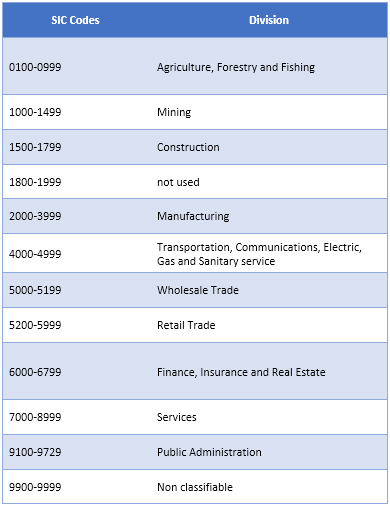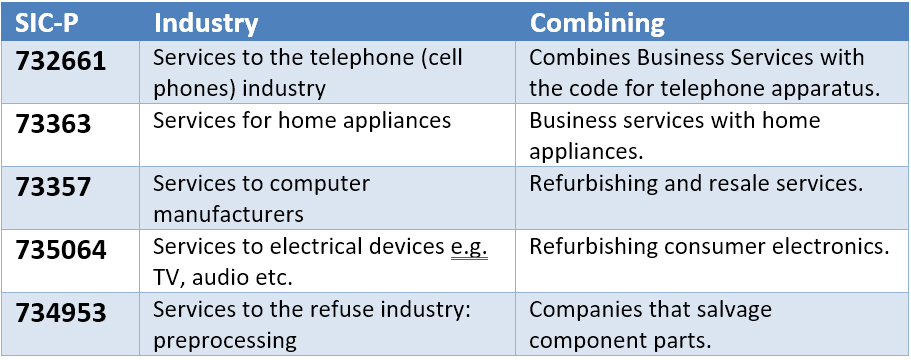SIC codes and Reverse Logistics: Part 1
By Ken Jacobson, RLA Standards Comm. Co-Chair & Sheng Li, Univ. Of Nevada, Reno, RLA Intern, Reverse Logistics Association
The Standard Industrial Classification (SIC) was originally developed in the 1930s to classify establishments by the type of activity in which they are primarily engaged. The taxonomy of business activity reflected the perspective of an economy that was dominated by agriculture and manufacturing. Now 68% of the US GDP is from the service industry. SIC codes had their last and only update in 1987 by the Office of Management and Budget (OMB). As a result of this pre-Internet taxonomy, businesses often force-fit themselves into SIC code designations that don’t accurately reflect what they can actually do.
 In 1997, a parallel new system was introduced: NAICS—the North American Industry Classification System. It expanded the ten broad categories of the SIC system to twenty broad categories. It coordinated this taxonomy with both Canada and Mexico. Instead of the four digits SIC system, NAICS uses six digits for more granularity. Still, the realities of the post Internet era are not reflected in its taxonomy. Now, we have two different systems, and it is confusing.
In 1997, a parallel new system was introduced: NAICS—the North American Industry Classification System. It expanded the ten broad categories of the SIC system to twenty broad categories. It coordinated this taxonomy with both Canada and Mexico. Instead of the four digits SIC system, NAICS uses six digits for more granularity. Still, the realities of the post Internet era are not reflected in its taxonomy. Now, we have two different systems, and it is confusing.
NAICS numbers are the standard for federal economic study applications. SIC codes however are still used. SIC codes can be used to classify companies for tax purposes. Banks and creditors use SIC codes to identify the industry a company belongs to when considered extending credit. They are used for marketing and direct mailing. The insurance industry also relies upon SIC codes for rates. U.S. Securities and Exchange Commission (SEC) continued to use SIC codes. As of yet, there are no plans to phase out the older SIC system.
SIC codes usually consist of four digits. The first two digits are major group designators. The final two add more granularity. Some services add extra numbers for proprietary purposes. Services provided to the major divisions specifically are not designated as “Services,” but deemed part of that division of industry. All of the divisions include a category of “other things that don’t fit.”
The reverse logistics industry is complex. Many of its facets don’t fit. Every manufacturer and retailer must deal with the issue of returns and other aspects of customer service after the initial sale. It includes processes for actually collecting and vetting returns, repairing and repackaging them, reselling them, and ultimately recycling them: Return, Repair, Resell and Recycle. Manufacturers and retailers manage 68% of these functions internally, but there is a large industry that provides third-party support and services for these functions. These by definition are within the Service Industry. Collectively, together with companies that supply software, tools, and services to those third parties, they comprise the reverse logistics industry. They are a key component of the circular economy.
Many of these services are large industries in and of themselves, and reverse logistics is only a portion of their business. The transportation/logistics industry is complex. They provide forward and reverse logistics. A layer of out-sourced services, often referred to as Third Party Logistics (3PL) has emerged that specializes in managing this complexity. They deal with freight brokers, carriers, and delivery services. There are over 45,000 companies in the US that provide such services, and about a thousand that just do packing and crating. Two SIC codes are common: 4731 and 4783 (packing and crating).
Warehousing is another ancillary industry that supports reverse logistics—as well as forward logistics and storage. There are three common SIC codes for this industry as it relates to reverse logistics: 4225, 4226, and 7389. There are about 25,000+ companies with this designation—plus thousands of personal and mini-storage facilities. Often, these facilities are offering additional services related to reverse logistics, such as disposition and repackaging. There is no SIC (nor NAICS) classification for companies that provide repackaging services, nor for disposition services. These are classified as “other services.”
The secondary sales channel within reselling is still another industry that is a critical component of reverse logistics. While the SIC taxonomy for both wholesale and retail is comprehensive, its ancient roots do not include the phrase “consumer electronics.” Further, it does not distinguish desk computers that replaced typewriters from larger data processing systems, or even from home computers and tablets. Is a tablet a computer or a toy? The SIC manual does have a designation for “used merchandise (5932)” but does this include “refurbished goods?” Or Ecommerce? Amazon is classified as 5961—Catalog and Mail-Order Houses. The Internet? What’s that? Much of the resale of refurbished products is conducted as Ecommerce. Companies that buy and resell used cell phones are generally designated as Industry: 7389—Business Services, Not Elsewhere Classified. These are essential components of the reverse logistics industry which is a critical component of our circular economy.
The recycling industry is also in disarray with regards to SIC codes. While most produce sent to the trash are simply “trashed” (4953 Refuse Systems), electronic equipment and some other products require special processing due to their potential impact on the environment, before going into a landfill. Commonly, electronic recycling companies simply use the two-digit category designation of Major Group 49: Electric, Gas, And Sanitary Services, or Major Group 42: Hauling services. (Since SIC codes are four digits it is common to see 4949 or 4242—both of which are invalid codes.) Some specialty services, e.g., batteries or disk drives, may designate themselves as belonging to the Major Group of engineering services (87).
This brings us to the remaining component of reverse logistics and the most complex. As retailers and manufacturers seek to outsource much of the process, a class of businesses have emerged that provide eclectic combinations of services to meet customer requirements. Broadly speaking they are often referred to as Third Party Service Providers (3PSP). They range from companies that provide specific and specialized services—such as certifying disk drive erasures to “cradle-to-grave” services. Many started with a narrower focus such as repairs or aggregation and storage. Their customers—often large manufacturers asked for more and they responded, “we can do that….”
Think about the process of returns for a second. A customer phones for authorization or returns a product to a store. Reverse logistics begins with customer support. There are 3PSP companies that provide customer support and warranty management. The returned product is examined, and its disposition determined. That process can also be outsourced. A minority of products can be directly returned to inventory. Most at least require repackaging. Many need repairs or refurbishing prior to being repackaged.
Many returns are then transported to a secondary sales channel or liquidators instead of back to the original retailer. The circular economy is experiencing high growth in this segment of the process. Eventually the device is salvaged for reusable parts and the rest is erased or shredded and then sent to a landfill. Many manufacturers brag that less than 1% of their returns go to landfill.
Most 3PSP companies provide an array of these services. Many subcontract to other service providers to offer turn-key services. What SIC codes are appropriate? What does a company choose as a SIC designation when they refurbish and resell electric razors?
The Reverse Logistics Association has a large community of companies that subscribe to its magazine and newsletters. It has a database of these companies and has collected SIC code information from their community. It has analyzed the codes of those companies that are designated as 3PSPs. There is not much agreement. For example, a company that actually does refurbish and resells electric scooters lists itself as a transportation company (4731). Actually, a significant number of 3PSPs use that designation.
Some common business configurations emerge. Some offer transport, repair, and return. Many offer resale as refurbished goods—often through ecommerce. Some also provide repair services for consumers (about 40%). Some second channel companies purchase used goods (especially cell phones or gaming machines) for refurbishment and resale. Some resell wholesale and others direct to consumers: some sell to both.
They have a lot in common despite the variations in their services: they are service companies. As such they should be categorized under Major Group 73: Business Services. Many are and many simply use 7373. That is a designation for Computer Integrated Systems Design, which is a designation for what used to be called Value Added Resellers and System Integrators. Nobody checks. The use of 7373 as a designator by 3PSP companies was meant as a doublet of the Major Category 73: Business Services.
As a result of this chaos, true metrics for the circular economy are elusive. The market value of the reverse logistics industry cannot accurately be ascertained. The only valid numbers come from manufacturers come who know how much they sell and what percentage of their products are returned to them. Retailers, too, know how many they sell and how many are returned to them. They only return some of these to the manufacturer. Manufacturers and retailers do not (generally) share each other’s numbers.
The processes of the reverse logistics and the circular economy also add revenue and value through warranty reserves, product insurance disbursements, repair costs, resale of refurbished goods and salvaged parts. One ton of iPhones would deliver 300 times more gold than a ton of gold-ore and 6.5 times more silver than a ton of silver-ore. The true value of this industry includes the transportation costs and disposal costs: these are revenue streams for other companies. In many ways it is a sub rosa industry. In this era where concerns about sustainability and recycling have emerged as economic priorities, this secondary industry has become figural in both politics and commerce. We live in a world where the Dell-to-Best Buy ecosystem competes with the Refurbisher-to-eBay for the same customer.
A functional definition of the reverse logistics process includes returns, repair, resale and recycling. While many of these processes are performed in-house by manufacturers and retailers, the third-party outsourcing ecosystem is expanding and morphing into its own economy. It consists of outsourced warranty and customer support services, transportation and warehousing companies, secondary sales channel companies, recycling companies, and 3PSP companies. The SIC code structure does not avail itself to easily track the evolution of this industry.
We have noted that the selection of a SIC – especially after the introduction of the NAICS structure is not regulated. We have noted that some companies report just the first two digits of a major category. Others create a portmanteau such as 7373, still, others report five- or six-digit codes—though only the first four are required.
This versatility suggests a solution—especially for those companies that are square pegs trying to fit into round holes. While transportation seems to have adequate designations, many others do not. Note: all third-party vendors of services related to reverse logistics are service companies. Thus, they belong in Major Group 73: Business services. Many meaningful portmanteaus can be created: (examples)

A portmanteau normally combines two words into one. We have used that principle to concatenate SIC code: Thus SIC-P codes. While some companies designated as 3PSPs are essentially repair shops and use the SIC codes such as 7378 or 7379, many offer a complex array of services that go beyond simple repair. While there are always the last resort codes for “things that don’t belong anywhere else”, we contend that using SIC-P codes will enable a clearer delineation of the reverse logistics industry. Many companies record multiple SIC codes. Maybe a SIC-P code can be added to yours.
Ken Jacobson, RLA Standards Comm. Co-Chair & Sheng Li, Univ. Of Nevada, Reno, RLA Intern